 Expressing Milk
Expressing Milk

Once established, breastfeeding is a real joy, but there are times when being able to express milk so that someone else can
feed your baby is important. HOWEVER, unless there is a medical or other problem, you SHOULD NOT begin expressing milk
before your feeding routine is established: probably when your baby is about six weeks old. Giving expressed milk before
this can lead to several problems including your baby rejecting the breast in favour of a bottle, and reduced stimulation of
your milk supply.
There are two main issues associated with giving expressed breastmilk:
- Firstly, How will you collect the milk? You can hand or pump express, but if using a pump, which type?
- Secondly, How will you give the milk to your baby - it may not be a simple as you think!

Hand Expressing
This is really good when you get the hang of it: you can express anywhere, anytime with no fuss or special equipment and anyone can do it, but can be a bit tricky to start with. If you can bear it, I really recommend that you to get someone to show you how... yes literally! It was a little embarrasing, but I had a midwife express my milk for me, and without such "hands on" help I'm sure I would never have got the technique right. Qualified assistants are there to help in whatever way you need it, but they will be understanding and noone will be offended if you say what you are, and what you are not, comfortable with.
To hand express: |
|

HOSPITAL STYLE, FULLY ELECTRIC PUMPS:£150 upwards to buy, £1/day rental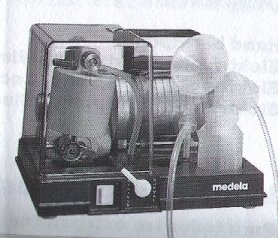 These pumps are large and expensive, you would probably only see one if you need to express milk in hospital, or you decide
These pumps are large and expensive, you would probably only see one if you need to express milk in hospital, or you decide
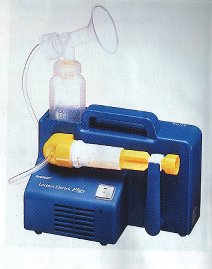 to rent one for whatever reason. They are mains powered suction units, about the size of a day bag, to which you attach a
collection kit via plastic tubing. There are two makes that I know of: Egnell have an old fashioned one that is still widely
seen, and a more compact modern pump known as the "Elite". The "Elite" is very adjustable, you can taylor the level of suction
to rent one for whatever reason. They are mains powered suction units, about the size of a day bag, to which you attach a
collection kit via plastic tubing. There are two makes that I know of: Egnell have an old fashioned one that is still widely
seen, and a more compact modern pump known as the "Elite". The "Elite" is very adjustable, you can taylor the level of suction
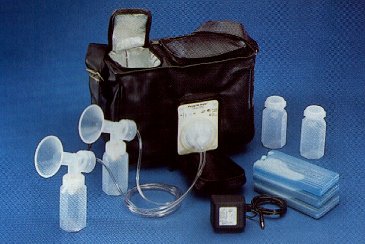 and speed of the cycles to best suit your body, and so it can be extremely sucessful. Egnell pumps tend to be used throughout
the NHS, and can be rented from the NCT. Medela also produce rental pumps which can be privately hired. The "Lactina" is very
similar to the "Elite" with a three level adjustable suction. It boasts a "natural sucking cycle" with a "relax phase", I
found it to be the only pump which I actually managed to get significant amounts of milk from. The Medela "Pump-in-style"
is supposed to be a very good breast pump, based on the Lactina, and is availble to buy. It is pretty expensive, but I
would recommend it for someone needing to express milk daily, for example if you return to work and wish to continue complete
breastfeeding.
and speed of the cycles to best suit your body, and so it can be extremely sucessful. Egnell pumps tend to be used throughout
the NHS, and can be rented from the NCT. Medela also produce rental pumps which can be privately hired. The "Lactina" is very
similar to the "Elite" with a three level adjustable suction. It boasts a "natural sucking cycle" with a "relax phase", I
found it to be the only pump which I actually managed to get significant amounts of milk from. The Medela "Pump-in-style"
is supposed to be a very good breast pump, based on the Lactina, and is availble to buy. It is pretty expensive, but I
would recommend it for someone needing to express milk daily, for example if you return to work and wish to continue complete
breastfeeding.
|
BATTERY/MAINS PUMPS:£25-£45 to buy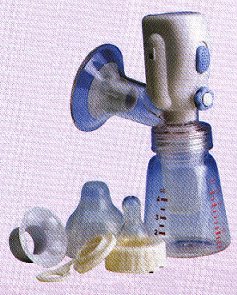
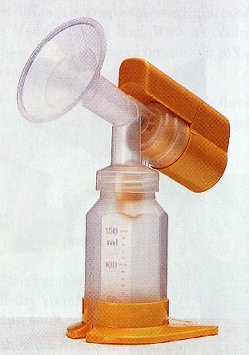 These are often "converted" hand pumps, which have had an electric motor attached where the hand pump has a lever. I haven't
actually heard of anyone who is particularly impressed with this type of pump. However, the Medela collection kit which is
used with the Lactina or Pump-in-style pumps can be converted to a two-handed hand pump, and there is also an upgrade kit to
make it into a "mini-electric": If I was going to use a pump of this type this is the one I would try! I have heard that the
battery operated ones are very "battery hungry", and I have also heard them described as noisey, but to be fair I cannot
comment on this.
These are often "converted" hand pumps, which have had an electric motor attached where the hand pump has a lever. I haven't
actually heard of anyone who is particularly impressed with this type of pump. However, the Medela collection kit which is
used with the Lactina or Pump-in-style pumps can be converted to a two-handed hand pump, and there is also an upgrade kit to
make it into a "mini-electric": If I was going to use a pump of this type this is the one I would try! I have heard that the
battery operated ones are very "battery hungry", and I have also heard them described as noisey, but to be fair I cannot
comment on this.
|
£20-£35 to buy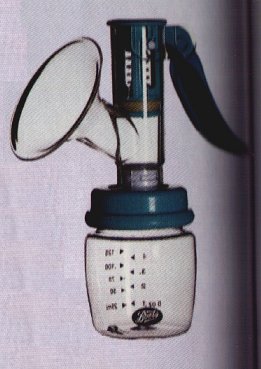
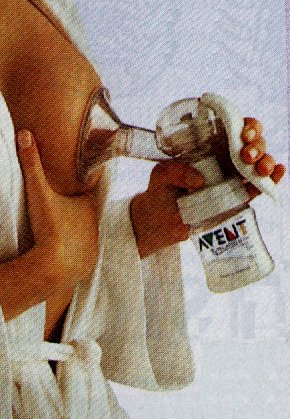
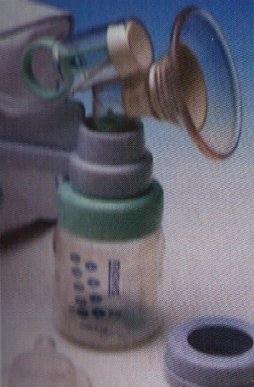
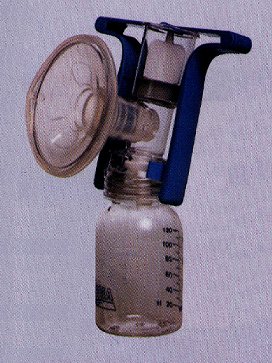 These are essentially a cone which attaches to a bottle, and there is some kind of lever which you pump. You are supposed
to be able to hold the pump, correctly positioned on the breast, and activate the mechanism with just one hand! They
are meant to be pretty straight forward to use. I believe they are considered the best type of pump for occasional use, and
perhaps what you should go for if you need to pump a few times a week... maybe even upto once a day.
You can naturally vary the suction and rhythm of the pump by you own action, and they are not too hard to operate. The
Avent ISIS pump is an example of this type of pump, and one which has been strongly recommended to me by a friend.
These are essentially a cone which attaches to a bottle, and there is some kind of lever which you pump. You are supposed
to be able to hold the pump, correctly positioned on the breast, and activate the mechanism with just one hand! They
are meant to be pretty straight forward to use. I believe they are considered the best type of pump for occasional use, and
perhaps what you should go for if you need to pump a few times a week... maybe even upto once a day.
You can naturally vary the suction and rhythm of the pump by you own action, and they are not too hard to operate. The
Avent ISIS pump is an example of this type of pump, and one which has been strongly recommended to me by a friend.
|
TWO HANDED, HAND PUMPS:£15-£30 to buy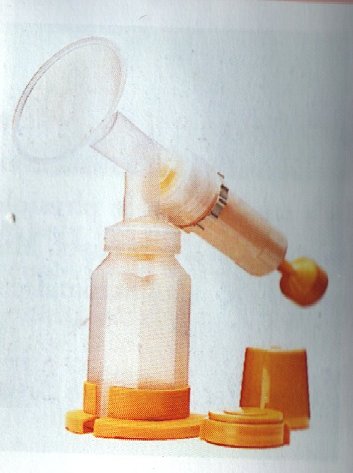 Again a cone which attaches to a bottle, with a pump action requiring one hand to hold the pump in position against the
breast, whilst the other hand actions the mechanism. There are a few types of mechanisms available, and I have been told
that the "bulb" type mechanism is rarely effective because you cannot get enough suction. I can however recommend the Medela
hand pump which relies on a handle that you pull in and out at the top of the pump: this type of mechanism is common,
effective, and VERY HARD WORK. This pump would be fine for very occasional use and emergencies. It is not something you
could use daily, for example when returning to work.
Again a cone which attaches to a bottle, with a pump action requiring one hand to hold the pump in position against the
breast, whilst the other hand actions the mechanism. There are a few types of mechanisms available, and I have been told
that the "bulb" type mechanism is rarely effective because you cannot get enough suction. I can however recommend the Medela
hand pump which relies on a handle that you pull in and out at the top of the pump: this type of mechanism is common,
effective, and VERY HARD WORK. This pump would be fine for very occasional use and emergencies. It is not something you
could use daily, for example when returning to work.
|
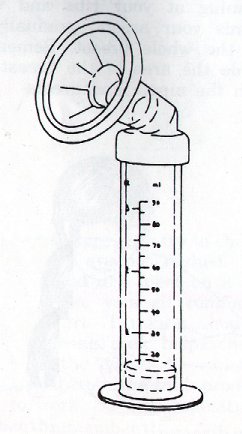
CYLINDER HAND PUMPS:£8-£15A cheap pump. The old fashioned design is supposed to be very effective, I have no idea how easy they are to actually use, but I suggest they are comparable to the two-handed pump - probably more difficult to begin with, but easier with practice. If you only need to pump occasionally why not have a cheap pump? |
Keep an eye out for silicone cushions which help to stimulate milk, and can make pumping more comfortable. It is also worth checking what other accessories come with a pump...(even if they are not useful you are probably paying for them indirectly).

GOOD LUCK!
Click here, for more information on support for breastfeeding and pump rental
Feeding Expressed Breast Milk
This may be a bit trickier than expected: a baby who has only ever been breastfed won't know what to do with a bottle!
You may find that your baby will prefer to take a bottle from someone other than yourself, and often a good way to introduce
the idea is for dad to give the first bottle. Your baby will be able to smell the "real thing" when you hold him, and it is
natural that he may not bother trying the bottle you are offering. I have heard of a mother who got around this by wearing
some of the daddy's clothes in order to feed her baby! Matthew would never take a bottle of me... but he was quite happy to
take it, if he was allowed to hold it himself, this may be worth bearing in mind if you have a slightly older baby.
Teats come in every imaginable shape and size under the sun...and if you are having trouble introducing a bottle it is well
worth trying out different ones. Even one brand can be subtley different from another and this could make all the difference
to your baby!
Considerations when choosing a teat:
